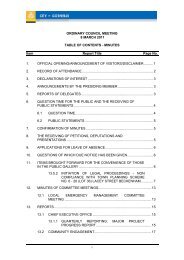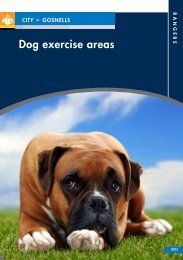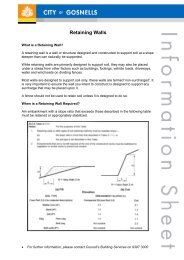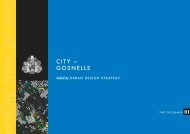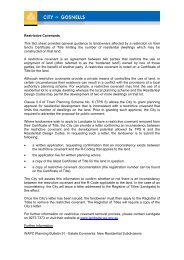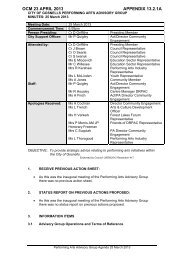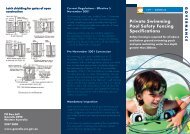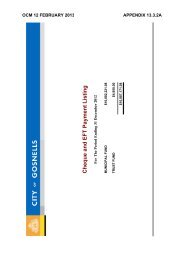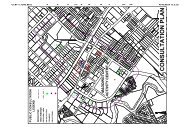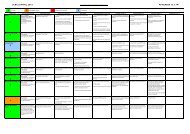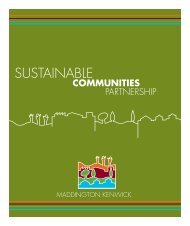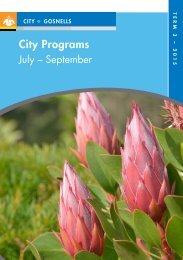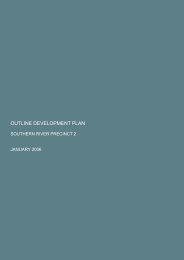Summary - City of Gosnells
Summary - City of Gosnells
Summary - City of Gosnells
You also want an ePaper? Increase the reach of your titles
YUMPU automatically turns print PDFs into web optimized ePapers that Google loves.
Vegetation 555.2 Vegetation Field SurveyIn order to compare the MKSEA vegetation with the data available from the literature and assess itsconservation significance, the floristic, structural and habitat data from the current survey were analysed in ahierarchical manner, as outlined below.1. Vegetation units recorded in the current MKSEA Field Survey.The MKSEA data were first classified and mapped using a simple vegetation structure approach. Thisprovided a preliminary (and purely descriptive) overview <strong>of</strong> the range <strong>of</strong> fine-scale vegetation units thatwere recorded in the MKSEA without attempting to relate the vegetation to any previous classifications.2. Vegetation <strong>of</strong> the MKSEA in comparison to vegetation within the local conservation estate.The fine-scale vegetation units above were then compared to units that have been described and/ormapped previously (at a similar scale) within the Greater Brixton Street Wetlands and in the CliffordStreet Bush Forever Site (Marshall, 2000; Government <strong>of</strong> Western Australian, 2000; VCSRG, 2001,Keighery and Tauss, 2008; Tauss, 2009). This comparison was carried out to determine if there wereany vegetation types present in the MKSEA that were not represented locally within the conservationestate.3. The conservation significance <strong>of</strong> the vegetation recorded in the current field survey.The floristic data <strong>of</strong> the MKSEA were then numerically classified in the context <strong>of</strong> the SCP database <strong>of</strong>Gibson et al. (1994) to examine the statistical similarity between the vegetation <strong>of</strong> the MKSEA and theFCTs and TECS <strong>of</strong> the SCP as defined by Gibson et al. (1994). The results <strong>of</strong> this analysis were thencritically reviewed (by considering the limitations <strong>of</strong> the above approach, the total evidence <strong>of</strong> floristics,vegetation structure and habitat available from the MKSEA and from other studies <strong>of</strong> the SCP) to assessthe conservation values <strong>of</strong> the MKSEA vegetation and map these values.5.2.1 Vegetation units recorded in the current MKSEA field SurveyThe MKSEA vegetation data were first classified according to the vegetation structure <strong>of</strong> the tallest layer(i.e. forest, woodland, mallee, tall shrubs, low shrubs or rushes/sedges) and the dominant species <strong>of</strong> this layer(e.g. Corymbia calophylla, Melaleuca rhaphiophylla, Actinostrobus pyramidalis, Melaleuca lateriflora,Banksia telmatiaea, Meeboldina cana). Further division within the above categories was then made when theunderstorey included distinctive and unusual, dominant species (e.g. dense Cyathochaeta teretifolia sedges)or the understorey was degraded and it was not possible to reliably infer original composition. This provideda simple, first pass overview <strong>of</strong> the range <strong>of</strong> fine-scale vegetation units that are present in the MKSEAwithout attempting to relate the vegetation to any previous classifications. From the data collected in thereconnaissance survey and the 32 sampling quadrats and relevés established within the current MKSEA fieldstudy it was possible to define and map 28 vegetation units, at a scale <strong>of</strong> 1: 2,000, within the MKSEA (Table5.4). These vegetation units are described below.Vegetation Unit T1: Corymbia calophylla low woodland to low open forest over Xanthorrhoea preissiiand/or Kingia australis, low shrubs that <strong>of</strong>ten include Pericalymma ellipticum, Hypocalymma angustifoliumMud Habitat Variant (C.Tauss 1850) and Hakea sulcata, and an open perennial rush and sedge layer withCyathochaeta avenacea, Mesomelaena tetragona and Tetraria octandra.This unit was in good to very good condition and inhabited palusplains <strong>of</strong> shallow muddy sand over sandymud and clay between about 13 m and 16 m AHD. The understorey <strong>of</strong> this vegetation was in very goodcondition in a block in Precinct 1 <strong>of</strong> the MKSEA, where it had been carefully managed to control weeds inthe understorey and to exclude fire. On two adjacent blocks the canopy <strong>of</strong> this vegetation unit was intact, butthe understorey was dominated by weeds in some places, probably due to frequent burning. However, therewere no highly invasive weeds present in theseblocks that could not be controlled successfully with amoderate management regime that would enable natural regeneration and recruitment <strong>of</strong> native species fromthe adjoining very good condition bushland. The large Corymbia calophylla trees in this vegetation areimportant native fauna habitat (for native birds, bats and possums); they provide connectivity <strong>of</strong> habitatbetween the forest <strong>of</strong> the Darling Range and the woodlands <strong>of</strong> the SCP, and they also have high landscapevalue.Tauss, C. and Weston, A.S. (2010). The flora, vegetation and wetlands <strong>of</strong> the Maddington-Kenwick Strategic Employment Area.A survey <strong>of</strong> the rural lands in the vicinity <strong>of</strong> the Greater Brixton Street Wetlands. Report to the <strong>City</strong> <strong>of</strong> <strong>Gosnells</strong>, W.A. Version 18.04.10



